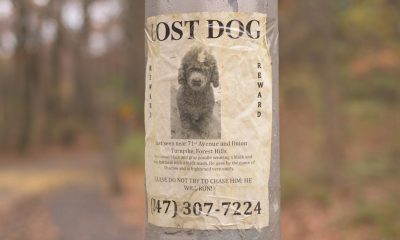Teeth of man who lived 4,000 years ago give insight into human diet evolution
They were among skeletal remains excavated from a limestone cave.
Published
1 month ago onBy
Talker News
By Stephen Beech via SWNS
The teeth of an Irishman who lived 4,000 years ago have given "unprecedented" insight into the evolution of the human diet.
They were among skeletal remains excavated from a limestone cave at Killuragh, County Limerick, by archaeology Professor Peter Woodman, of University College Cork, before his death in 2017.
Scientists have uncovered well-preserved microbiomes from two of the Bronze Age teeth.
They contained bacteria that cause gum disease, as well as the first high-quality ancient genome from S. mutans, an oral bacterium that is one of the major causes of tooth decay.
The discoveries, described in the journal Molecular Biology and Evolution, allowed the research team to assess the impact of past dietary changes on the oral microbiome across thousands of years, including major changes coinciding with the popularisation of sugar and industrialization.
The teeth, both derived from the same Bronze Age man, also provided a "snapshot" of oral health in the past, with one tooth showing evidence of microbiome imbalance.
Microbial DNA extracted from ancient human teeth can provide information on the evolution of the oral microbiome.
The excellent preservation of DNA in fossilized dental plaque has made the oral cavity one of the best-studied aspects of the ancient human body.
However, scientists have retrieved very few full genomes from oral bacteria from before the Medieval era.

Researchers have limited knowledge about prehistoric bacterial diversity and the relative impact of recent dietary changes compared to ancient ones, such as the spread of farming starting about 10,000 years ago.
S. mutans is the primary cause of dental cavities and is very common in oral microbiomes.
However, it is exceptionally rare in the ancient genomic record.
Scientists believe one reason for its rarity could be its acid-producing nature as the acid causes the tooth to decay, but also degrades DNA and prevents plaque from mineralizing.
They suspect the absence of S. mutans DNA in ancient mouths could also reflect less favorable habitats for the species across most of human history.
Archaeologists have observed an uptick in dental cavities in skeletal remains following the adoption of cereal agriculture, but cavities became much more common in the Early Modern period, beginning about 1500 AD.
While other teeth in the Irish cave showed advanced dental decay there was no evidence of caries on the sampled teeth.
But the researchers revealed one tooth root yielded an "unprecedented" quantity of mutans sequences.
Study senior author Dr. Lara Cassidy, an Assistant Professor at Trinity College Dublin, said: “We were very surprised to see such a large abundance of mutans in this 4,000-year-old tooth.
“It is a remarkably rare find and suggests this man was at high risk of developing cavities right before his death.”
She believes the cool, dry, and alkaline conditions of the cave may have contributed to the exceptional preservation of S. mutans DNA, but its high abundance also points to dysbiosis.
The researchers found that while S. mutans DNA was plentiful, other streptococcal species were virtually absent from the tooth sample.
They said that implies that the natural balance of the oral biofilm had been upset – mutans had outcompeted the other species leading to a pre-disease state.
The team says the study lends support to the “disappearing microbiome” hypothesis, which proposes the microbiomes of our ancestors were more diverse than our own today.
Alongside the S. mutans genome, the research team reconstructed two genomes for T. forsythia – a bacteria involved in gum disease – and found them to be highly divergent from one another, implying much higher levels of strain diversity in prehistoric populations.
Study first author Iseult Jackson, a PhD candidate, said: “The two sampled teeth contained quite divergent strains of T. forsythia.

“These strains from a single ancient mouth were more genetically different from one another than any pair of modern strains in our dataset, despite these modern samples deriving from Europe, Japan, and the USA.
"This is interesting because a loss of biodiversity can have negative impacts on the oral environment and human health.”
She said the reconstructed T. forsythia and S. mutans genomes revealed "dramatic" changes in the oral microenvironment over the last 750 years.
In recent centuries, one lineage of T. forsythia has become dominant in global populations.
The researchers said that is the tell-tale sign of a selective episode – where one strain rises rapidly in frequency due to some genetic advantage.
The team found that post-industrial T. forsythia genomes have acquired many new genes that help the bacteria colonize the oral environment and cause disease.
S. mutans also showed evidence of recent lineage expansions and changes in gene content, which coincide with the popularisation of sugar.
However, the researchers found that modern S. mutans populations have remained more diverse than T. forsythia, with deep splits in the mutans evolutionary tree pre-dating the Killuragh genome.
They believe it was driven by differences in the evolutionary mechanisms that shape genome diversity in the species.
Dr. Cassidy added: “S. mutans is very adept at swapping genetic material across strains.
“This allows an advantageous innovation to be spread across mutans lineages, rather than one lineage becoming dominant and replacing all others.”
She said that, in effect, both the disease-causing bacteria have changed "dramatically" from the Bronze Age to today, but it appears that very recent cultural transitions - such as the consumption of sugar - have had an "inordinate" impact.
Stories and infographics by ‘Talker Research’ are available to download & ready to use. Stories and videos by ‘Talker News’ are managed by SWNS. To license content for editorial or commercial use and to see the full scope of SWNS content, please email [email protected] or submit an inquiry via our contact form.
You may like


Blood test can detect signs of knee condition 8 years before X-rays


Rare condition that stunts growth also reduces heart attack risk


Research reveals mice think just like human babies


Harvard study reveals how pollution raises risk of heart attack or stroke


Does taking the stairs instead of an elevator help you live longer?


Dog theft causes same emotional turmoil as losing a child: study
Other Stories


Blood test can detect signs of knee condition 8 years before X-rays
Early detection could lead to treatments that slow the progression of the most common form of arthritis.


Man captures ultra rare albino squirrel on camera
The white squirrel has red eyes so is thought to be an albino squirrel.


Adorable dog kicks his leg while he walks
A video captured the pup bouncing along the street of his native China.


Woman with rare ‘Sleeping Beauty’ condition sleeps every four hours
She was diagnosed at age 18 after years of struggling to stay awake in school and nodding off during class.


97-year-old veteran receives WWII service medal 80 years later
"We’re all so proud of Eve."
Top Talkers

 Parenting1 week ago
Parenting1 week agoSingle mom details struggles of feeding her 12 kids

 Lifestyle1 week ago
Lifestyle1 week agoWoman regrets her tattoo nightmare: ‘It’s horrendous’

 Good News4 days ago
Good News4 days agoDisabled student takes first steps in 10 years on graduation stage

 Wildlife3 days ago
Wildlife3 days agoClever elephant returns visitor’s shoe that fell into enclosure

 Health4 days ago
Health4 days agoNew study reveals ‘old age’ begins later than it used to

 Entertainment1 day ago
Entertainment1 day agoWhat is the perfect movie length?

 Broadcast10 hours ago
Broadcast10 hours agoAre allergies interfering with your social life?

 Work2 days ago
Work2 days agoHow much does your workspace affect productivity?
